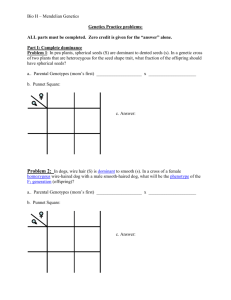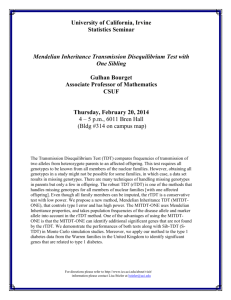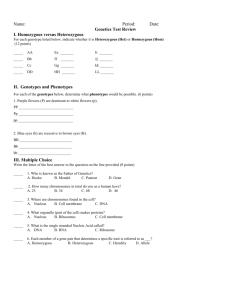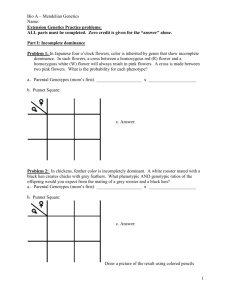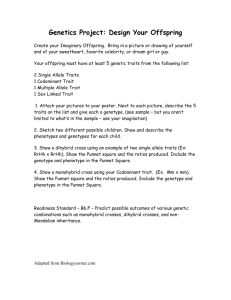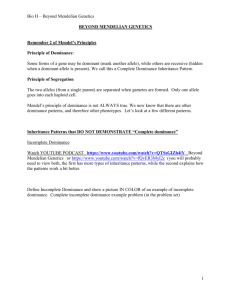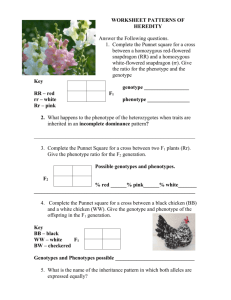Genetics Practice problems:
advertisement
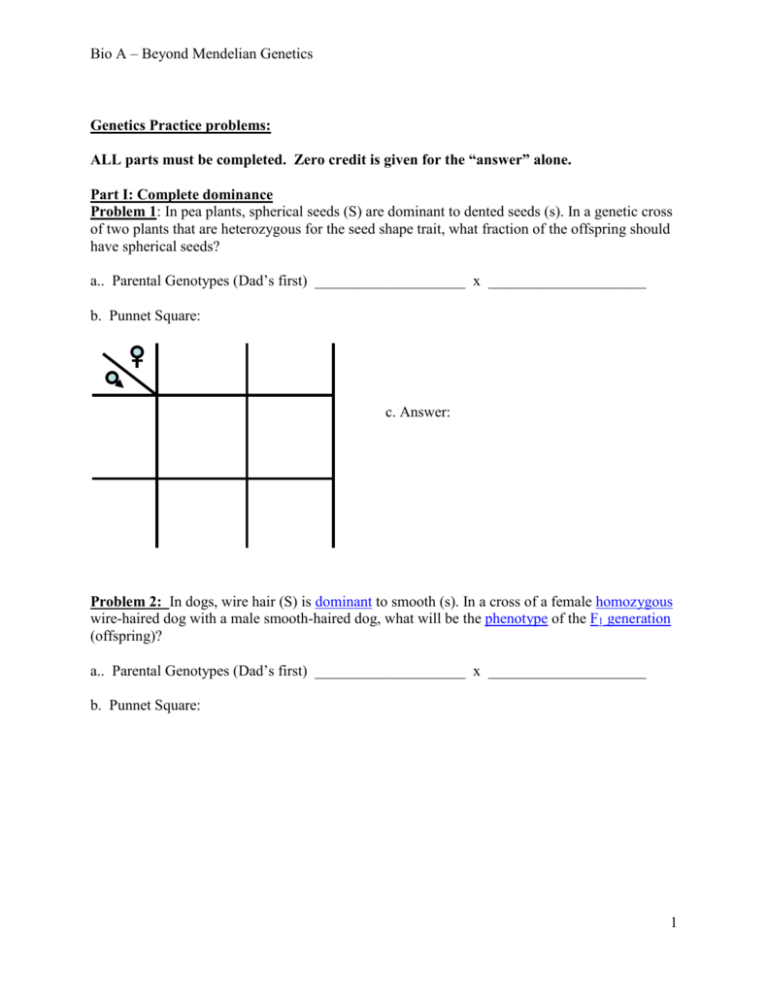
Bio A – Beyond Mendelian Genetics Genetics Practice problems: ALL parts must be completed. Zero credit is given for the “answer” alone. Part I: Complete dominance Problem 1: In pea plants, spherical seeds (S) are dominant to dented seeds (s). In a genetic cross of two plants that are heterozygous for the seed shape trait, what fraction of the offspring should have spherical seeds? a.. Parental Genotypes (Dad’s first) ____________________ x _____________________ b. Punnet Square: c. Answer: Problem 2: In dogs, wire hair (S) is dominant to smooth (s). In a cross of a female homozygous wire-haired dog with a male smooth-haired dog, what will be the phenotype of the F1 generation (offspring)? a.. Parental Genotypes (Dad’s first) ____________________ x _____________________ b. Punnet Square: 1 Bio A – Beyond Mendelian Genetics c. Answer: 2 Bio A – Beyond Mendelian Genetics Problem 3: Woodrats are medium sized rodents with lots of interesting behaviors. You may know of them as packrats. Let's assume that the trait of bringing home shiny objects (H) is dominant to the trait of carrying home only dull objects (h). Suppose two heterozygous individuals are crossed. What would be the expected genotypic ratio of the progeny (offspring)? ALSO how many of the progeny bring home shiny objects? a.. Parental Genotypes (Dad’s first) ____________________ x _____________________ b. Punnet Square: c. Answer: (2 parts) Problem 4: The common grackle is a species of blackbird that is fairly common in the United States. Suppose that long tails (L) were dominant to short tails in these birds. A female shorttailed grackle mates with a male long-tailed grackle who had one parent with a long tail and one parent with a short tail. What percentage of the offspring have a genotype of Ll? What percentage of the offspring would have a long tail? a.. Parental Genotypes (Dad’s first) ____________________ x _____________________ b. Punnet Square: c. Answer: (2 parts) 3 Bio A – Beyond Mendelian Genetics Part II: Incomplete dominance Problem 1: In Japanese four o’clock flowers, color is inherited by genes that show incomplete dominance. In such flowers, a cross between a homozygous red (R) flower and a homozygous white (r) flower will always result in pink flowers. A cross is made between two pink flowers. What is the probability for each phenotype? a.. Parental Genotypes (mom’s first) ____________________ x _____________________ b. Punnet Square: c. Answer: Problem 2: In chickens, feather color is incompletely dominant. A white rooster mated with a black hen creates chicks with grey feathers. What phenotypic AND genotypic ratios of the offspring would you expect from the mating of a grey rooster and a black hen? a.. Parental Genotypes (mom’s first) ____________________ x _____________________ b. Punnet Square: c. Answer: Draw a picture of the result using colored pencils 4 Bio A – Beyond Mendelian Genetics Part III: Co-dominance Problem 1: In shorthorn cattle, the hybrid between red and white is roan. Roan means that the animal has BOTH red hairs AND white hairs. If a roan is bred with a white, what will the phenotypic ratio be? a.. Parental Genotypes (mom’s first) ____________________ x _____________________ b. Punnet Square: Draw a picture of the result using colored pencils: c. Answer: Multiple Alleles (mixture of co-dominance and complete dominance) Problem 2: Blood type in humans is determined by the presence of 2 of 3 possible alleles. The alleles are IA, IB and iO. IA is completely dominant to iO. IB is completely dominant to iO. IA and IB are co-dominant with each other. Suppose a female who is homozygous for Type A blood marries a male who is heterozygous for type B blood. Their first child is type AB and their second child is type O. Do both these children belong to the same father? Explain. a. Parental Genotypes (mom’s first) ____________________ x _____________________ b. Punnet Square: c. Answer: 5 Bio A – Beyond Mendelian Genetics Part IV: Sex-linked Problems Problem 1: The ability to see color is determined by a gene found on the X chromosome. When this gene is defective, it causes colorblindness. A colorblind person can not distinguish between certain colors, such as red and green. The good news is that the “normal” allele is dominant to the colorblind allele. Suppose a Colorblind Female marries a normal male. Can they have any male children who can see color? Can they have any female children who can see color? a.. Parental Genotypes (mom’s first) ____________________ x _____________________ b. Punnet Square: c. Answer: (2 parts) Problem 2: Hemophilia is a disease where the blood does not clot very well. The mutated gene that causes this disease is found on the X chromosome. Again, the mutation is recessive and the normal allele is dominant. Suppose you have a Homozygous normal female and a male with hemophilia. What is the probability of getting a healthy child (male or female)? What fraction of the male children will be healthy? a.. Parental Genotypes (mom’s first) ____________________ x _____________________ b. Punnet Square: c. Answer: (2 parts) 6 Bio A – Beyond Mendelian Genetics Part V: Test Crosses Problem 1: A florist knows the up-coming holiday will put a large demand on red roses (R). He wants to make sure that his Red rose plant is PURE so that he doesn’t get a lot of white flowers (r) when he pollinates the plant. a. What possible genotypes might his red plant be? b. What genotype should he cross his rose with to identify its genotype? c. Draw out BOTH possible punnett squares below: d. By looking at the offspring of the test cross, how will he tell if his plant is pure? Problem 2: A dog breeder knows he can sell a beagle that is PURE for a “slim neck” for more than he can sell a hybrid. A hybrid has a chance of producing the recessive “thick neck” beagle, which is considered undesirable. He crosses his “slim neck” beagle with a “thick neck” beagle and 8 puppies are born. 5 are “slim neck” and 3 are “thick neck”. a. Can he determine if his beagle is pure or not? b. If so, how? If not, why not? Problem 3: A farmer wants to produce all yellow corn. He knows that sometimes corn comes out yellow, sometimes it comes out white and sometimes it comes out with both yellow and white kernels. He has heard that test crosses can help his case. To make sure that his plant can only produce yellow kernels, he crosses his yellow plant with a yellow/white plant. He gets a mixture of yellow and yellow/white offspring. He decides his plant is NOT pure for the yellow allele. a. Did the farmer have to perform a test cross to determine the genotype of his corn? Explain? 7 Bio A – Beyond Mendelian Genetics VI. Dihybrid Crosses (to be demonstrated in class) Problem 1: In mice the gene for coat color as two forms. The allele for dark coat is dominant to the allele for albino. There are two forms for the gene controlling whiskers, as well, straight is dominant to bent. Cross two mice that are heterozygous for both these genes. a. What is the genotype of each mouse? b. What possible gametes can each mouse make (remember each gamete contains one allele for EACH trait being considered)? c. Draw out the Punnett square for this cross d. What proportion of the offspring are albino? e. What proportion would have bent whiskers? f. What is the phenotypic ratio of ALL the offspring? (be sure to include the traits!) 8 Bio A – Beyond Mendelian Genetics Problem 2: If a maize plant heterozygous for the alleles for pigmy and crinkly-leaf (both recessive to normal size of plant and normal leaf) is self-pollinated and 208 seeds are subsequently collected and germinated, how many would you expect to show: a. crinkly leaves? b. normal size? c. normal leaves and normal size? d. normal leaves and pigmy size? 9 Bio A – Beyond Mendelian Genetics 10
